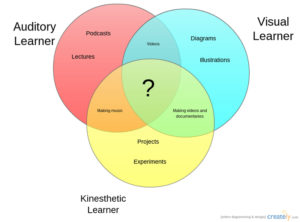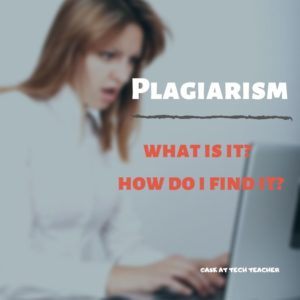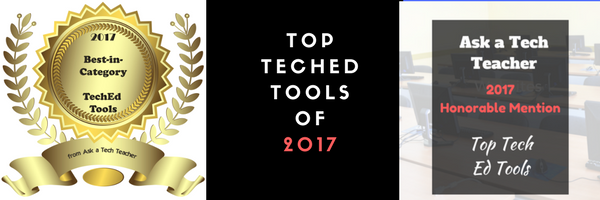Year: 2018
What is the VARK model of Student Learning?
 If you use the VARK model of Student Learning, you know why I’m excited about it. VARK started as a questionnaire to help students and teachers understand their best approach to learning but has since become more of a guideline for teaching and learning. The questionnaire is deliberately short (thirteen-sixteen questions, depending upon which version you take) in order to prevent student survey fatigue.
If you use the VARK model of Student Learning, you know why I’m excited about it. VARK started as a questionnaire to help students and teachers understand their best approach to learning but has since become more of a guideline for teaching and learning. The questionnaire is deliberately short (thirteen-sixteen questions, depending upon which version you take) in order to prevent student survey fatigue.
The acronym VARK refers to four learning modalities — Visual, Auditory, Reading/Writing, and Kinesthetic. Though often classroom lessons focus on the Visual, with a bit of preparation, they can be taught using all four modalities thus accommodating students who learn best in a different way. Why go through this extra effort? VARK’s creator, Neil Fleming, explains it this way:
- Students’ preferred learning modes have a significant influence on their behavior and learning.
- Information that is accessed through students’ use of their modality preferences shows an increase in their levels of comprehension, motivation, and metacognition.
For me, that extra time and effort is a no-brainer. Let me back up a moment and explain how I got to that point. I realized after a few years of teaching that something was wrong with the methodology I had been taught. Lots of clever, smart kids weren’t getting what I was putting out. I taught in a way that addressed how the majority learned (because that covered most kids, didn’t it?) but that turned out to be more like a plurality. Or less. In fact, where that plurality of kids might be the biggest group in the class, those that weren’t learning in this prescriptive manner was an even bigger group. To say it another way:
What the Bell Curve considers the “typical student” was always far outnumbered by those who weren’t.
Interestingly enough, Dr. Fleming reports that Kinesthetics (the K in VARK) is the most common learning style though not the most common teaching style.
Share this:
- Click to share on Facebook (Opens in new window) Facebook
- Click to share on X (Opens in new window) X
- Click to share on LinkedIn (Opens in new window) LinkedIn
- Click to share on Pinterest (Opens in new window) Pinterest
- Click to share on Telegram (Opens in new window) Telegram
- Click to email a link to a friend (Opens in new window) Email
- More
Citing Sources: The Infographic
EasyBib, the first name most educators think of when citing sources, has created a useful summary on MLA guidelines for citing sources. Best of all, it’s an infographic you can grab and post on your wall (with proper citation, of course):
Click here for the original post.
Share this:
- Click to share on Facebook (Opens in new window) Facebook
- Click to share on X (Opens in new window) X
- Click to share on LinkedIn (Opens in new window) LinkedIn
- Click to share on Pinterest (Opens in new window) Pinterest
- Click to share on Telegram (Opens in new window) Telegram
- Click to email a link to a friend (Opens in new window) Email
- More
Innovative Ways to Encourage Writing
 Knowledge is meant to be shared. That’s what writing is about–taking what you know and putting it out there for all to see. When students hear the word “writing”, most think paper-and-pencil, maybe word processing, but that’s the vehicle, not the goal. According to state and national standards (even international), writing is expected to “provide evidence in support of opinions”, “examine complex ideas and information clearly and accurately”, and/or “communicate in a way that is appropriate to task, audience, and purpose”. Nowhere do standards dictate a specific tool be used to accomplish the goals.
Knowledge is meant to be shared. That’s what writing is about–taking what you know and putting it out there for all to see. When students hear the word “writing”, most think paper-and-pencil, maybe word processing, but that’s the vehicle, not the goal. According to state and national standards (even international), writing is expected to “provide evidence in support of opinions”, “examine complex ideas and information clearly and accurately”, and/or “communicate in a way that is appropriate to task, audience, and purpose”. Nowhere do standards dictate a specific tool be used to accomplish the goals.
In fact, the tool students select to share knowledge will depend upon their specific learning style. Imagine if you–the artist who never got beyond stick figures–had to draw a picture that explained the nobility inherent in the Civil War. Would you feel stifled? Would you give up? Now put yourself in the shoes of the student who is dyslexic or challenged by prose as they try to share their knowledge.
When you first bring this up in your class, don’t be surprised if kids have no idea what you’re talking about. Many students think learning starts with the teacher talking and ends with a quiz. Have them take the following surveys:
- North Carolina State University’s learning style quiz
Both are based on the Theory of Multiple Intelligences, Harold Gardner’s iconic model for mapping out learning modalities such as linguistic, hands-on, kinesthetic, math, verbal, and art. Understanding how they learn explains why they remember more when they write something down or read their notes rather than listening to a lecture. If they learn logically (math), a spreadsheet is a good idea. If they are spatial (art) learners, a drawing program is a better choice.
Share this:
- Click to share on Facebook (Opens in new window) Facebook
- Click to share on X (Opens in new window) X
- Click to share on LinkedIn (Opens in new window) LinkedIn
- Click to share on Pinterest (Opens in new window) Pinterest
- Click to share on Telegram (Opens in new window) Telegram
- Click to email a link to a friend (Opens in new window) Email
- More
Best-in-Category Winners for 2017
Ask a Tech Teacher routinely shares favorite websites and apps that make a difference in the classroom. Over the last month, readers voted on which tools had the greatest impact on readers. To award this Best in Category badge, we asked them to look for the uncommon resources (meaning: not the ones everyone knows about), the ones that made them say Wow and rush to share with colleagues everywhere.
Then we looked for the following qualities:
- how dependable is it
- how versatile is it for time-strapped teachers
- does it differentiate for the varied needs of students and teacher
- do educators like it (fairly subjective, but there you have it)
- how did it work when exposed to your students
- was it easy to use and intuitive to learn
- did it fulfill promises and expectations
- has it become a beloved tool in your classes or a failed experiment
Here are the 2017 Best-in-Category and Honorable Mentions for the following Categories: (more…)
Share this:
- Click to share on Facebook (Opens in new window) Facebook
- Click to share on X (Opens in new window) X
- Click to share on LinkedIn (Opens in new window) LinkedIn
- Click to share on Pinterest (Opens in new window) Pinterest
- Click to share on Telegram (Opens in new window) Telegram
- Click to email a link to a friend (Opens in new window) Email
- More
Quick Review of 7 Popular Math Programs
 America’s student math scores continue to drop. Headlines such as “Less than half of Maryland students pass English, math assessments” and “Internationally, U.S. Students Are Falling” have become so common, we are almost immune to the message. The knee-jerk reaction “That’s not my school; that’s someone else’s” has become the excuse for fighting efforts to fix kids’ math aptitude when those fixes are outside the box or difficult. The problem is, tomorrow’s adults must be math proficient which means our kids must be. A preponderance of jobs today’s kids will get when they join the working world will require technology — and with that, the critical thinking developed by math. It’s no surprise conscientious schools are looking for more effective and reliable ways to teach that math. If your school has decided that what’s always worked doesn’t and will be evaluating math programs to find one that provides a real solution to the math aptitude problem, here are seven of the most popular you want to include: (more…)
America’s student math scores continue to drop. Headlines such as “Less than half of Maryland students pass English, math assessments” and “Internationally, U.S. Students Are Falling” have become so common, we are almost immune to the message. The knee-jerk reaction “That’s not my school; that’s someone else’s” has become the excuse for fighting efforts to fix kids’ math aptitude when those fixes are outside the box or difficult. The problem is, tomorrow’s adults must be math proficient which means our kids must be. A preponderance of jobs today’s kids will get when they join the working world will require technology — and with that, the critical thinking developed by math. It’s no surprise conscientious schools are looking for more effective and reliable ways to teach that math. If your school has decided that what’s always worked doesn’t and will be evaluating math programs to find one that provides a real solution to the math aptitude problem, here are seven of the most popular you want to include: (more…)
Share this:
- Click to share on Facebook (Opens in new window) Facebook
- Click to share on X (Opens in new window) X
- Click to share on LinkedIn (Opens in new window) LinkedIn
- Click to share on Pinterest (Opens in new window) Pinterest
- Click to share on Telegram (Opens in new window) Telegram
- Click to email a link to a friend (Opens in new window) Email
- More
How Tech Teachers Can Benefit From Historical Research Tools
 Teaching technology is a difficult profession because people learn in different ways and at different rates. However, one thing that can make it easier for students to learn is for teachers to include instructions on basic academic skills like vocabulary, keyboarding, digital citizenship, and research.
Teaching technology is a difficult profession because people learn in different ways and at different rates. However, one thing that can make it easier for students to learn is for teachers to include instructions on basic academic skills like vocabulary, keyboarding, digital citizenship, and research.
The better a student’s vocabulary, the easier it is for them to improve their comprehension and express themselves in oral and written form. The better a student learns how to use a keyboard, the faster and more accurately, they can work with a computer. The better a student’s digital citizenship, the more safely they can navigate the Internet websites, staying away from scammy links. Finally, the better a student’s research skills, the easier it will be for them to sort out the true from the false.
Technology has made it easier than ever before to do research. Besides an abundance of sources, the Internet provides ways to sift and sort through massive amounts of information through the use of search engines and advanced filters. Compare this to the old school way of doing research: spending hours in a large library and slowly filling out flash cards. Now research is as efficient as doing a Google search to find relevant websites and then bookmarking the site for later reference.
However, besides these online tools, tech teachers can also benefit by borrowing research tools used by historians.
Share this:
- Click to share on Facebook (Opens in new window) Facebook
- Click to share on X (Opens in new window) X
- Click to share on LinkedIn (Opens in new window) LinkedIn
- Click to share on Pinterest (Opens in new window) Pinterest
- Click to share on Telegram (Opens in new window) Telegram
- Click to email a link to a friend (Opens in new window) Email
- More
Support English Learners with Micro-credentials from Digital Promise
 Education is changing. Again. This time, it’s not about iPads and Chromebooks; it’s 1:1 computing. More than 50% of teachers report they have one computer for every student (on average) and that changes for the better every year. Digital devices, be they iPads, laptops, Chromebooks, Macs, or PCs, give students access to endless amounts of web-based resources for research, inquiry, collaboration, sharing, and more. Schools are no longer reliant on years-old (or decades-old) textbooks written for the average student, whoever that is. It has become increasingly possible to personalize learning–adapt resources and assessments to student skills and needs and differentiate lessons that are pushed out to individual students or small groups (read: Shifting my Teacher Mindset with Micro-credentials).
Education is changing. Again. This time, it’s not about iPads and Chromebooks; it’s 1:1 computing. More than 50% of teachers report they have one computer for every student (on average) and that changes for the better every year. Digital devices, be they iPads, laptops, Chromebooks, Macs, or PCs, give students access to endless amounts of web-based resources for research, inquiry, collaboration, sharing, and more. Schools are no longer reliant on years-old (or decades-old) textbooks written for the average student, whoever that is. It has become increasingly possible to personalize learning–adapt resources and assessments to student skills and needs and differentiate lessons that are pushed out to individual students or small groups (read: Shifting my Teacher Mindset with Micro-credentials).
To do that requires competencies most teacher training programs never considered. As a result, an increasing number of schools are making micro-credentials a fundamental piece in their professional development plan.
What are Micro-credentials?
Micro-credentials are short, low-cost, focused, online classes that are self-paced and student-driven, offering competency-based recognition for skills educators want to learn to buttress their teaching.
Because they aren’t long tedious seminars, expensive college classes, or comprehensive certificate courses, they were ignored by administrators in the past. Not anymore.
Share this:
- Click to share on Facebook (Opens in new window) Facebook
- Click to share on X (Opens in new window) X
- Click to share on LinkedIn (Opens in new window) LinkedIn
- Click to share on Pinterest (Opens in new window) Pinterest
- Click to share on Telegram (Opens in new window) Telegram
- Click to email a link to a friend (Opens in new window) Email
- More
14 Valentine Sites For Students
 Here are some fun Valentine sites to fill those few minutes betwixt and between lessons, projects, bathroom breaks, lunch, and everything else:
Here are some fun Valentine sites to fill those few minutes betwixt and between lessons, projects, bathroom breaks, lunch, and everything else:
- Apps
- Drag-and-drop
- Google Drawings Magnetic Poetry from Ctrl Alt Achieve
- Games and puzzles
- Games and stories
- ‘I love you’ in languages Afrikaans to Zulu
- Match
- Poem generator

- Puppy jigsaw
- Rebus game
- Sudoku
- Tic-tac-toe
- Typing
- Write in a heart
Do you use any I missed?
Holiday Lesson Plans
Looking for holiday lesson plans? Here’s my collection.
Share this:
- Click to share on Facebook (Opens in new window) Facebook
- Click to share on X (Opens in new window) X
- Click to share on LinkedIn (Opens in new window) LinkedIn
- Click to share on Pinterest (Opens in new window) Pinterest
- Click to share on Telegram (Opens in new window) Telegram
- Click to email a link to a friend (Opens in new window) Email
- More
Plagiarism: What it is and how to identify it
 Man is a thinking creature. We like evaluating ideas and sharing thoughts. That’s a good thing. The more we collaborate, the smarter we all become.
Man is a thinking creature. We like evaluating ideas and sharing thoughts. That’s a good thing. The more we collaborate, the smarter we all become.
Implicit in this is that we don’t claim someone else’s ideas as our own. In fact, it’s illegal to do this. Read through this rephrasing of American copyright law:
“The law states that works of art created in the US after January 1, 1978, are automatically protected by copyright once they are fixed in a tangible medium (like the Internet). BUT a single copy may be used for scholarly research (even if that’s a 2nd grade life cycle report) or in teaching or preparation to teach a class.” –Jacqui Murray, Ask a Tech Teacher
When we claim someone else’s work as our own, be it text, artwork, movies, music, or any other form of media, it’s called plagiarism:
“[Plagiarism is the] wrongful appropriation of another author’s language, thoughts, ideas, or expressions”
The rules and laws surrounding plagiarism aren’t nearly as well-known as those that deal with, say, driving a car or illegally crossing a street. The Josephson Institute Center for Youth Ethics surveyed 43,000 high school students and found that:
- 59% of high school students admitted cheating on a test during the last year. 34% self-reported doing it more than twice.
- One out of three high school students admitted that they used the Internet to plagiarize an assignment.
One note: Laws addressing plagiarizing differ throughout the world. This article deals with commonly-accepted international guidelines and specific rules aligned with the laws of the United States.
Share this:
- Click to share on Facebook (Opens in new window) Facebook
- Click to share on X (Opens in new window) X
- Click to share on LinkedIn (Opens in new window) LinkedIn
- Click to share on Pinterest (Opens in new window) Pinterest
- Click to share on Telegram (Opens in new window) Telegram
- Click to email a link to a friend (Opens in new window) Email
- More
5 Ways to Use JotForm Cards With Your Classes
![]() One of the fastest growing technologies in education is forms–to gather information, curate data, test students, and much more. There are lots of platforms available but for many, JotForm is the gold standard whether on PCs, Macs, or mobile devices. JotForm offers what seems to be an endless supply of professional-looking templates that can be used to sign up volunteers, get feedback on events, enroll students into classes, ask for donations, collect payments, and much more. Its drag-and-drop interface makes building forms intuitive, quick, and easy. New questions can be dependent upon the user’s response to prior questions and completed forms are shared via a link, social media, or integrated into DropBox, Google Docs, and other popular platforms. It is free with a pro version that offers expanded options. For more, here’s my review.
One of the fastest growing technologies in education is forms–to gather information, curate data, test students, and much more. There are lots of platforms available but for many, JotForm is the gold standard whether on PCs, Macs, or mobile devices. JotForm offers what seems to be an endless supply of professional-looking templates that can be used to sign up volunteers, get feedback on events, enroll students into classes, ask for donations, collect payments, and much more. Its drag-and-drop interface makes building forms intuitive, quick, and easy. New questions can be dependent upon the user’s response to prior questions and completed forms are shared via a link, social media, or integrated into DropBox, Google Docs, and other popular platforms. It is free with a pro version that offers expanded options. For more, here’s my review.
Now, JotForm just got better with JotForm Cards–-“the friendly way to ask”. JotForm Cards are engaging and easy to use which means a greatly improved response rate. Here’s what’s different about JotForm Cards from traditional forms:
Share this:
- Click to share on Facebook (Opens in new window) Facebook
- Click to share on X (Opens in new window) X
- Click to share on LinkedIn (Opens in new window) LinkedIn
- Click to share on Pinterest (Opens in new window) Pinterest
- Click to share on Telegram (Opens in new window) Telegram
- Click to email a link to a friend (Opens in new window) Email
- More








































